Institutional entry, the rise of stablecoins, and RWA on-chain are leading to a structural transformation in the crypto market.
Author: Ignas | DeFi Research
Translation: Deep Tide TechFlow
I really appreciate Ray Dalio's model in "Changing World Order" because it allows us to examine issues from a macro perspective and see the bigger picture.
Instead of getting lost in the daily "theater" of the cryptocurrency space, it’s better to focus on the long-term trends in the industry. This is also how we should view cryptocurrencies.
This is not just a rapid shift in narrative, but a fundamental change in the order of the entire industry.
The cryptocurrency market is no longer what it was in 2017 or 2021.
Here are several aspects where I believe the industry order has changed.
The Great Rotation: Asset Rotation in the Crypto Industry
The launch of Bitcoin and Ethereum ETFs marks a significant shift.
Just this month, the SEC approved the listing standards for exchange-traded products (ETPs). This means a faster approval process, allowing more assets to enter the market. Grayscale has already submitted applications based on this change.
Bitcoin ETFs have created the most successful issuance record in history. Ethereum ETFs started slower, but even in a weak market, they now hold billions in assets.
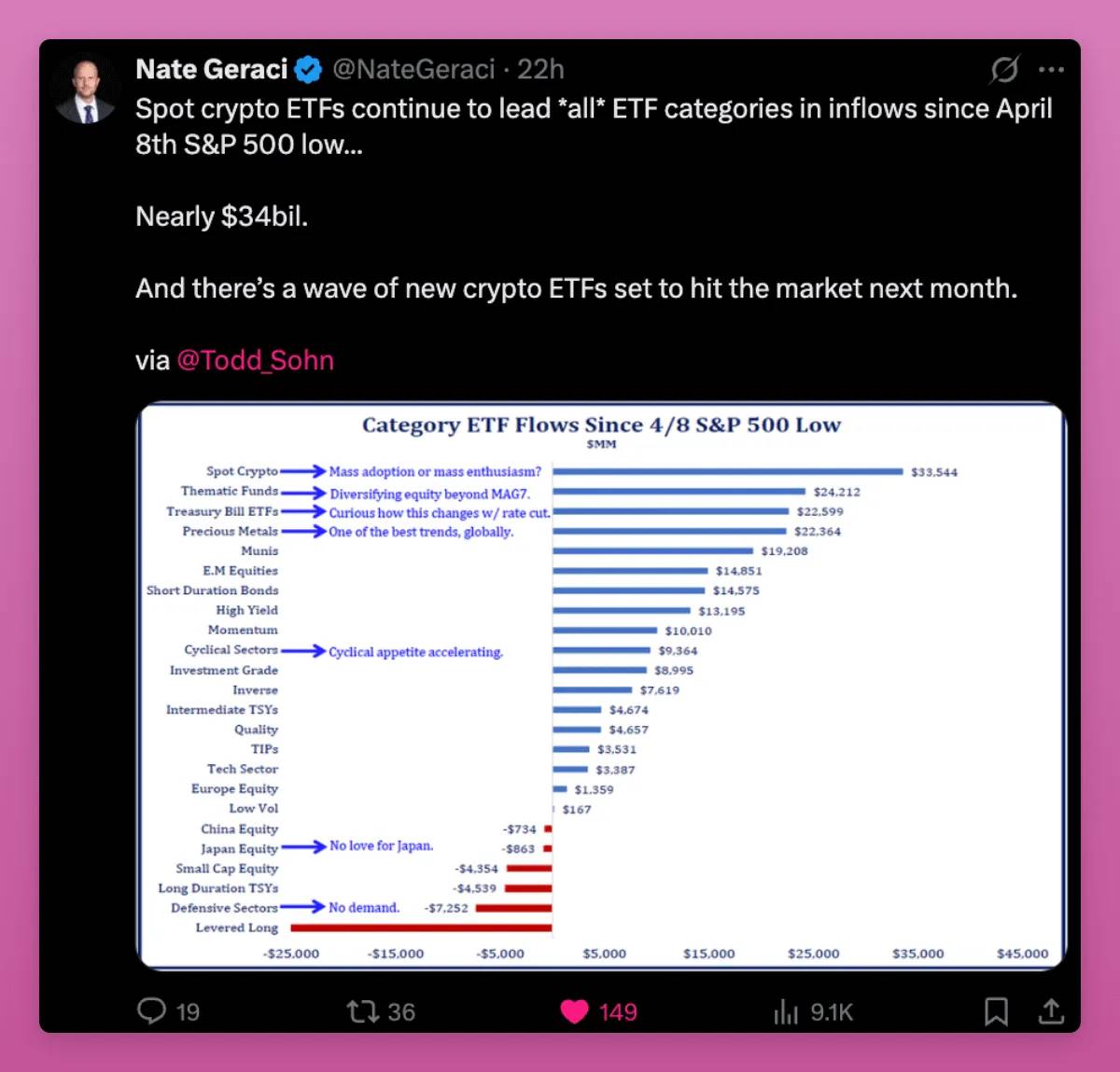
Since April 8, spot crypto ETFs have led all ETF categories in inflows, reaching $34 billion, surpassing thematic ETFs, government bonds, and precious metals.
Buyers include pension funds, advisors, and banks. Cryptocurrencies have now become part of portfolios, just like gold or the Nasdaq.
Bitcoin ETFs hold $150 billion in assets under management, accounting for over 6% of the total supply.

Ethereum ETFs account for 5.59% of the total supply.
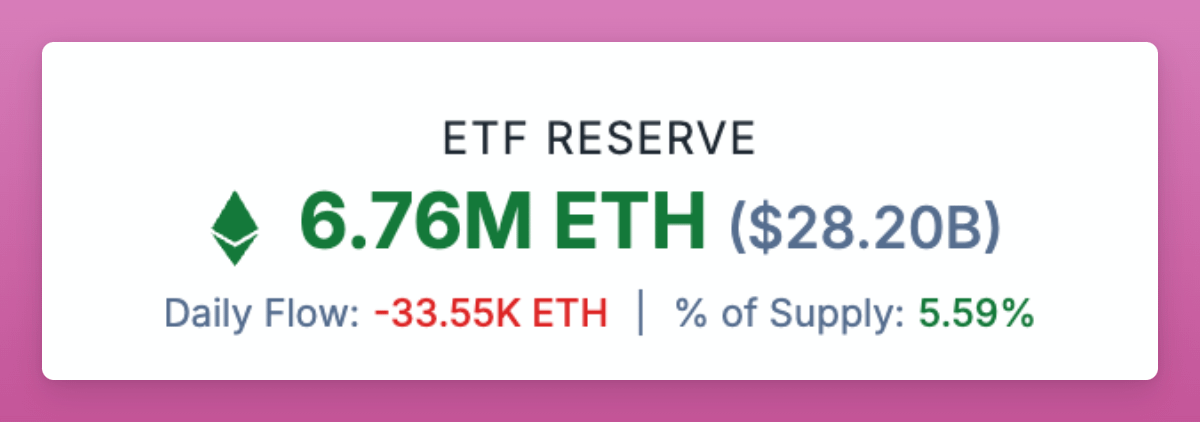
All of this has happened in just a little over a year.
ETFs are now the main buyers of Bitcoin and Ethereum, shifting the ownership base from retail to institutional. As seen in my posts, whales are buying while retail investors are selling.
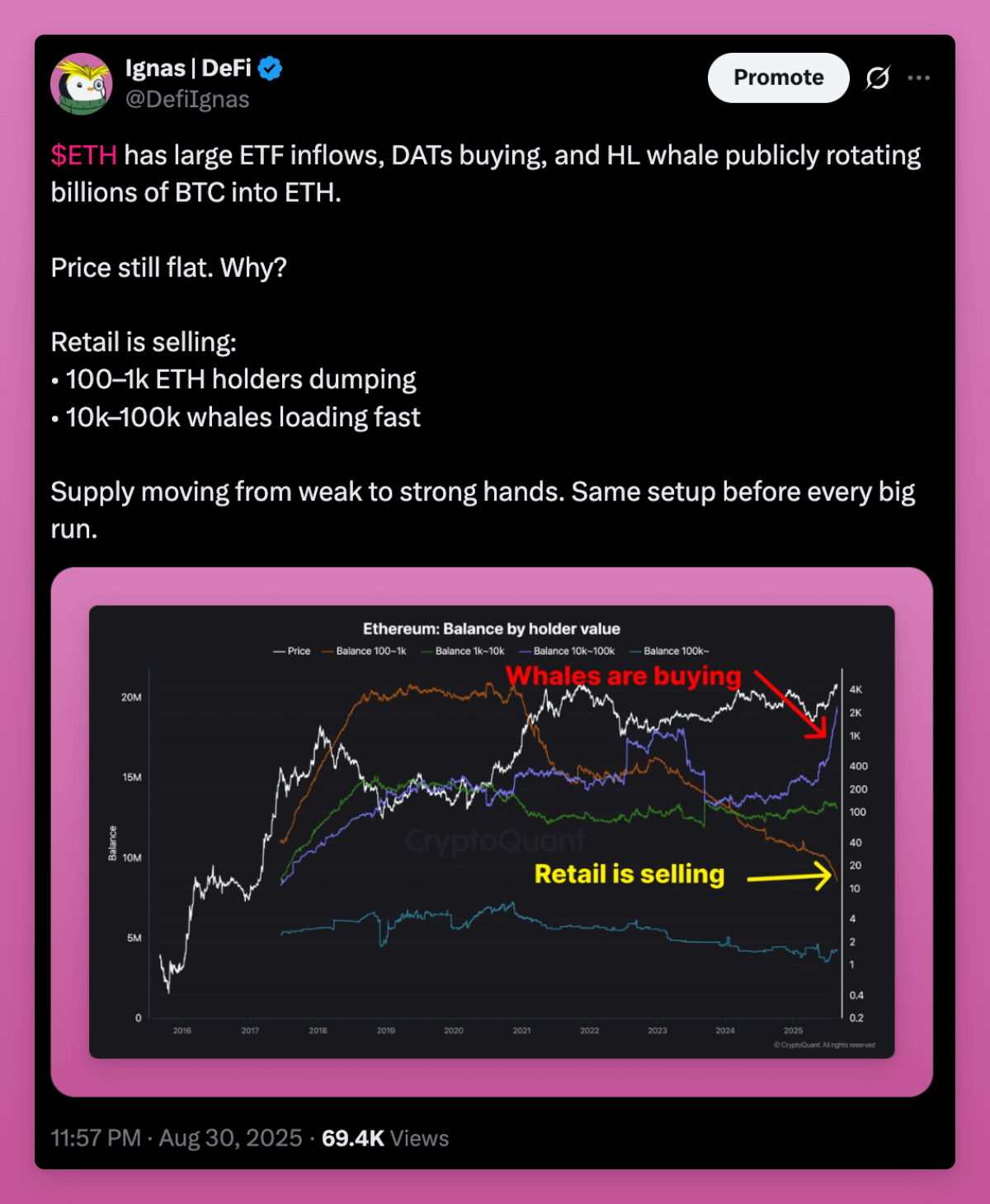
More importantly, "old whales" are selling their assets to "new whales."
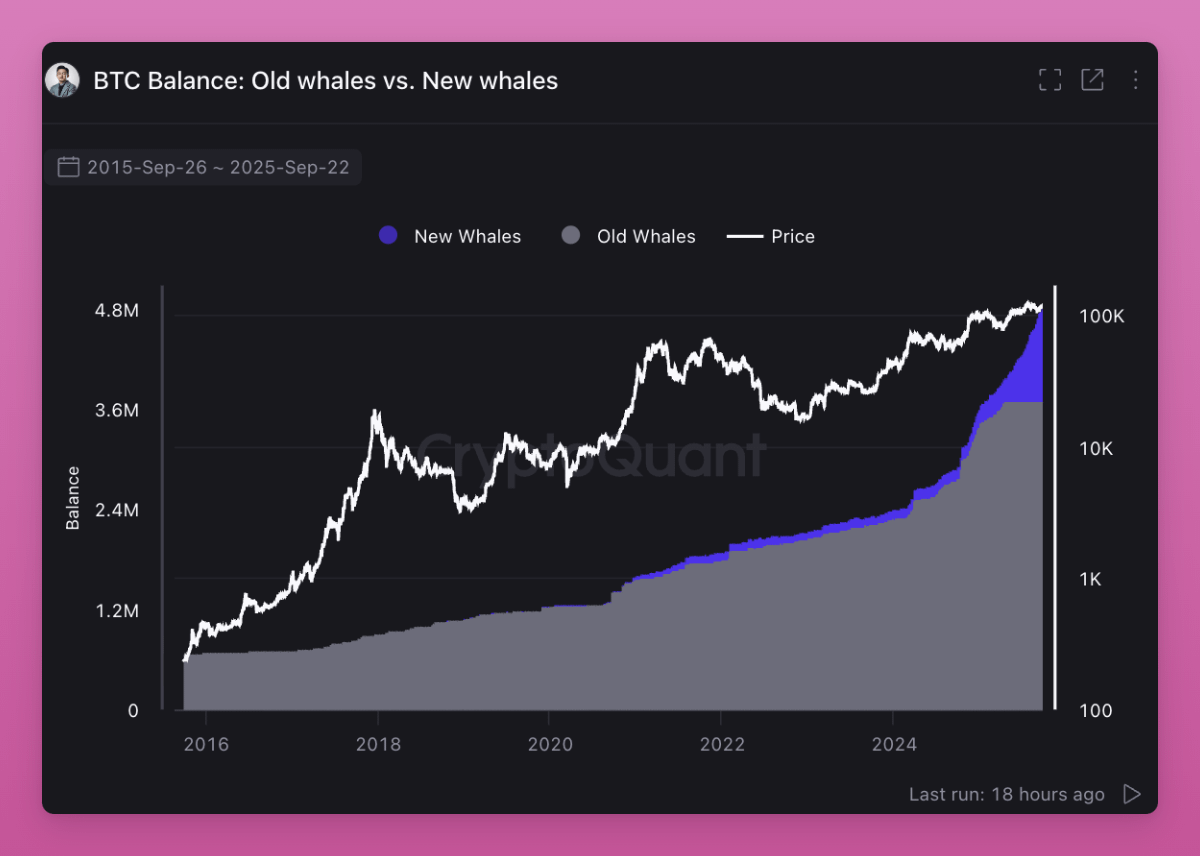
Ownership is rotating. Investors who believe in the four-year cycle are selling, expecting a repeat of the old script. However, something different is happening.
Retail investors who bought at low prices are selling their assets to ETFs and institutions. This transfer raises the cost basis while also elevating the bottom for future cycles, as new holders are less likely to sell on small profits.
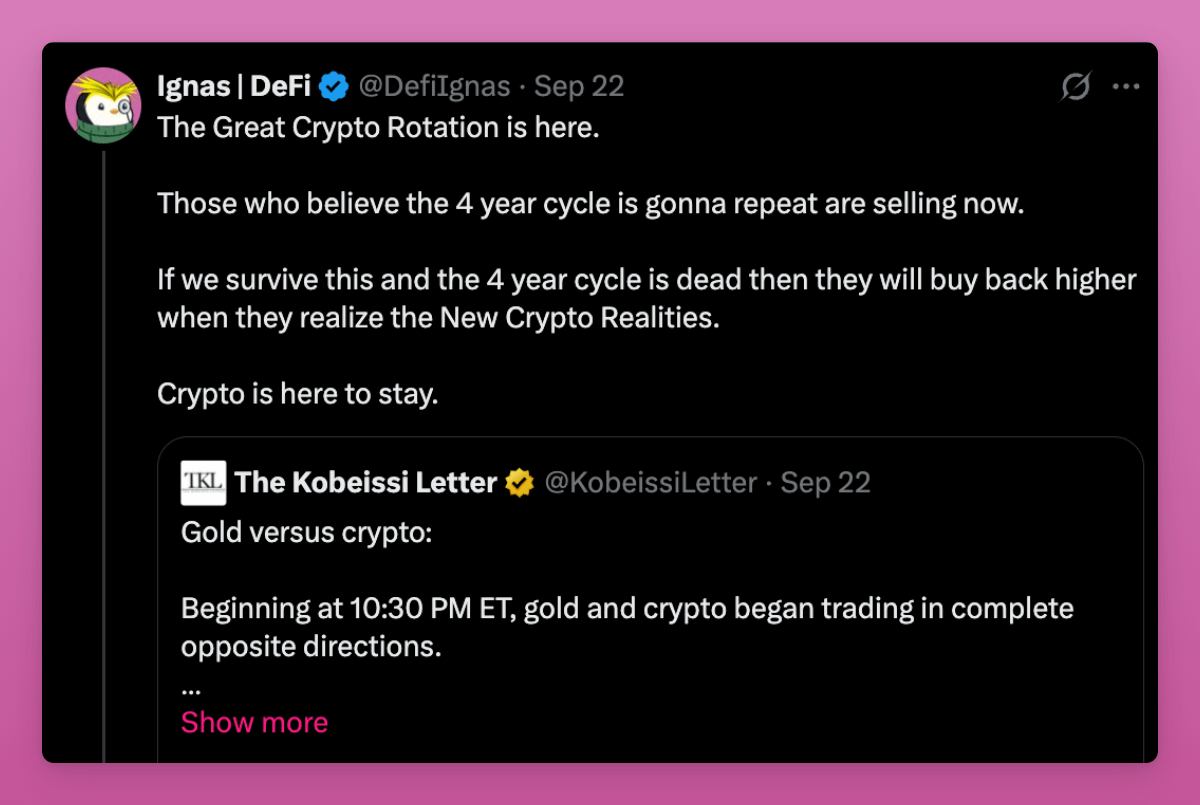
This is the great rotation in the crypto industry. Crypto assets are shifting from speculative retail hands to long-term allocators.
The universal listing standards have opened the next phase of this rotation.
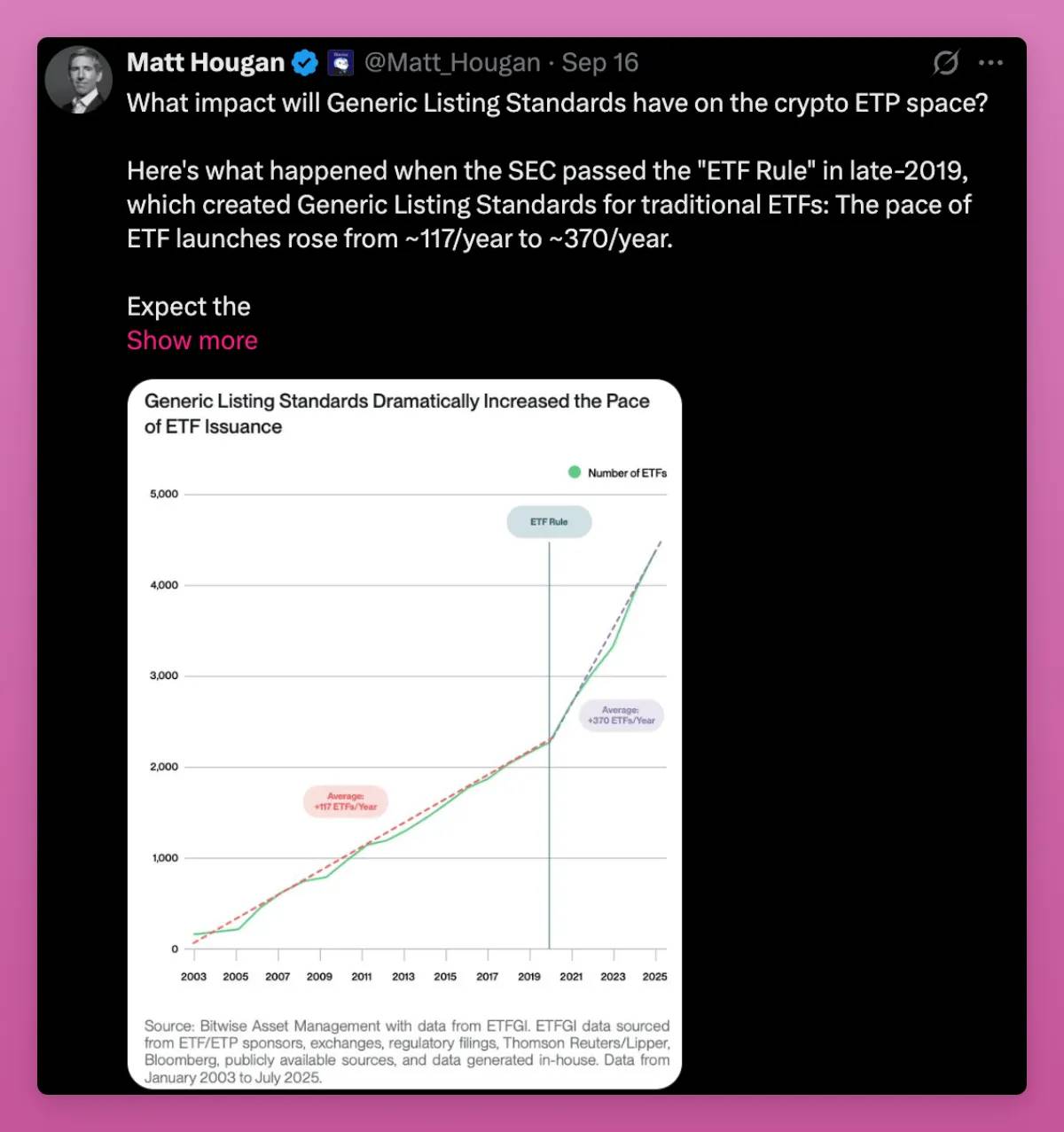
In 2019, similar rules in the stock market tripled the number of ETF issuances. A similar situation is expected in the crypto space. Many new ETFs are about to launch, such as SOL, HYPE, XRP, DOGE, etc., providing retail investors with exit liquidity.
The key question remains: Can institutional buying power balance the selling pressure from retail?
If the macro environment remains stable, I believe those who are selling now, expecting a four-year cycle, will buy back at higher prices.
The End of the Market Surge
In the past, the crypto market was usually correlated as a whole. Bitcoin would move first, followed by Ethereum, and then other assets would follow. Small-cap tokens would surge as liquidity flowed down the risk curve.
This time is different; not all tokens are rising in sync.
There are now millions of tokens in the market. New coins are launched daily on pump.fun, with "creators" shifting attention from old tokens to their own Memecoins. Supply is surging while retail attention remains unchanged.
Liquidity is dispersed across too many assets, as issuing new tokens comes at almost no cost.
In the past, low liquidity and high fully diluted valuation (FDV) tokens were popular and suitable for airdrops. But retail investors have learned their lesson. They are now more inclined to choose tokens that can provide value returns or at least have strong cultural appeal (e.g., $UNI, which, despite strong trading volume, failed to rise).
Ansem's viewpoint is correct; we have reached the peak of pure speculation. The new trend is revenue, as it has sustainability. Applications with product-market fit and fees will rise, while others will not.
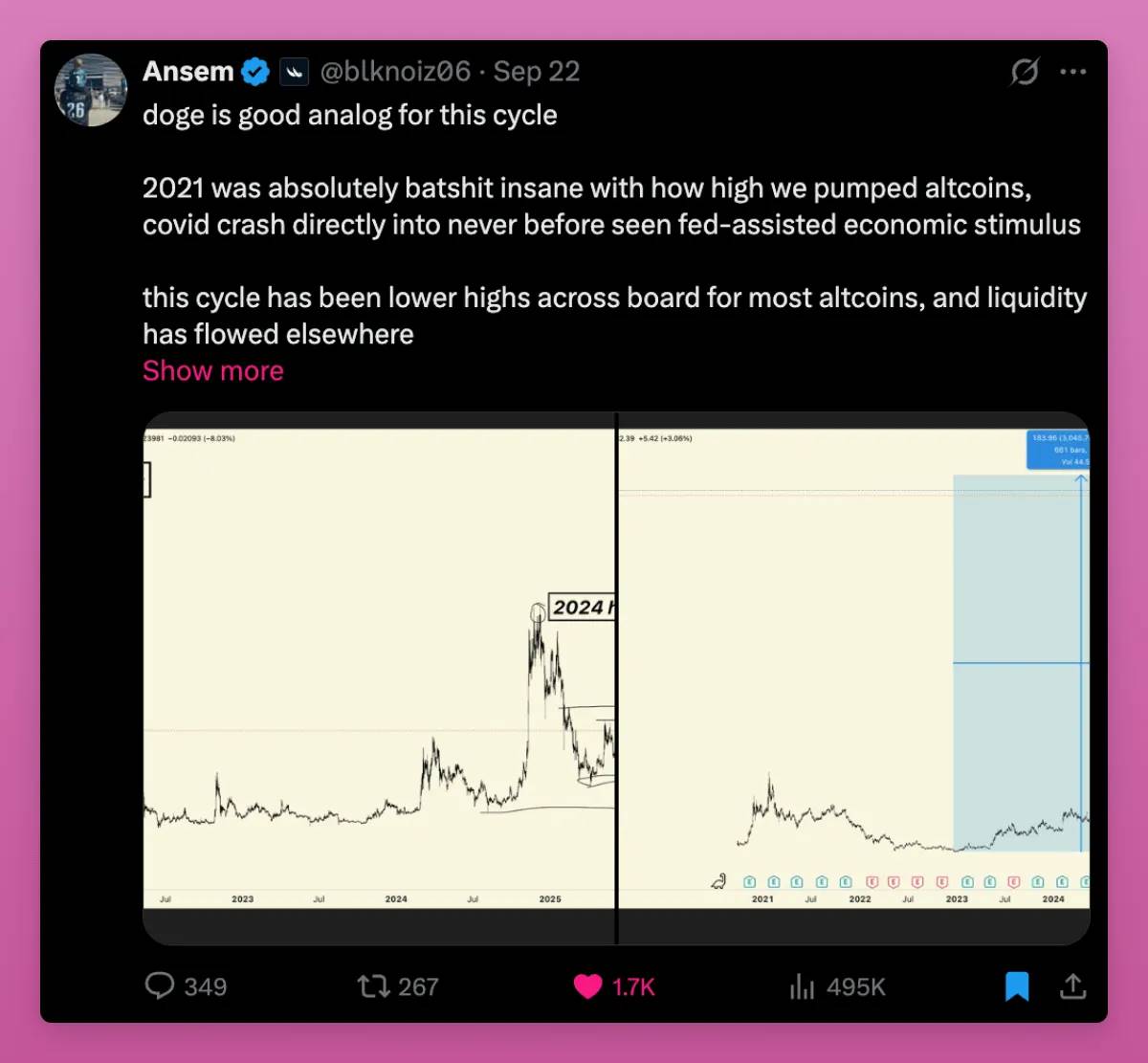
There are two notable points: users are paying high fees for speculation, and the efficiency of blockchain compared to traditional financial systems. The former has peaked, while the latter still has room for growth.
Murad raised another good point that I think Ansem overlooked. Tokens that are still able to rise are often new, strange, and easily misunderstood, but they have strong communities backing them. I am also one of those who enjoy novelty (like my iPhone Air).

Cultural significance determines the gap between survival and failure. A clear mission, even if it seems crazy at first, can keep a community engaged until the adoption snowball effect occurs. I would categorize Pudgy Penguins, Punk NFTs, and Memecoins in this category.
However, not all shiny new things will succeed. Runes, ERC404, etc., have shown me how novelty can fade quickly. Narratives may disappear before reaching critical mass.
I believe these viewpoints collectively explain the new order. Revenue filters out weak projects, while culture supports those that are misunderstood.
Both are important, but in different ways. The biggest winners will be the few tokens that can combine both.
Stablecoin Order Gives Credibility to the Crypto Industry
Initially, traders held USDT or USDC to purchase BTC and other cryptocurrencies. New capital inflows were bullish as they converted into spot purchases. At that time, 80% to 100% of stablecoin inflows were ultimately used to buy cryptocurrencies.
Now, the situation has changed.
Stablecoin funds are entering lending, payments, yield, treasury management, and airdrop mining. Some of this capital has never touched BTC or ETH spot purchases but has still enhanced the entire system. More L1 and L2 transactions. More DEX liquidity. More income in lending markets, such as Fluid and Aave. The money market of the entire ecosystem is deeper.
A new trend is L1s prioritizing payments.
Stripe and Paradigm's Tempo is designed for high-throughput stablecoin payments, equipped with EVM tools and native stablecoin AMMs.
Plasma is an L1 supported by Tether, designed for USDT, with banking applications and payment cards aimed at emerging markets.
These blockchains are pushing stablecoins into the real economy, not just trading. We are back to the topic of "blockchains for payments."
What could this mean (to be honest, I'm still not sure)?
Tempo: Stripe's distribution capability is immense. This helps with the widespread adoption of cryptocurrencies but may bypass spot demand for BTC or ETH. Tempo could ultimately be like PayPal: massive traffic but little value accumulation for Ethereum or other blockchains. What remains unclear is whether Tempo will issue a token (I think it will) and how much fee revenue will flow back into cryptocurrencies.
Plasma: Tether has already dominated USDT issuance. By connecting blockchain + issuer + application, Plasma could concentrate a significant portion of emerging market payments within a closed ecosystem. This is like the closed Apple ecosystem versus the open internet advocated by Ethereum and Solana. It raises the struggle for USDT's default chain status against Solana, Tron, and EVM Layer2. I think Tron suffers the most in this regard, while Ethereum was never a payment chain to begin with. However, the launch of Aave and other companies on Plasma poses a huge risk for ETH…
Base: The savior of ETH L2. As Coinbase and Base promote payments through the Base app and earn USDC yields, they will continue to drive up fees for Ethereum and DeFi protocols. The ecosystem remains decentralized but highly competitive, further expanding liquidity.
Regulation is aligning with this shift. The "GENIUS Act" is pushing other countries to catch up with stablecoins globally.
Additionally, the U.S. Commodity Futures Trading Commission (CFTC) has just allowed the use of stablecoins as tokenized collateral in derivatives. This has increased payment demand for non-spot needs in capital markets.
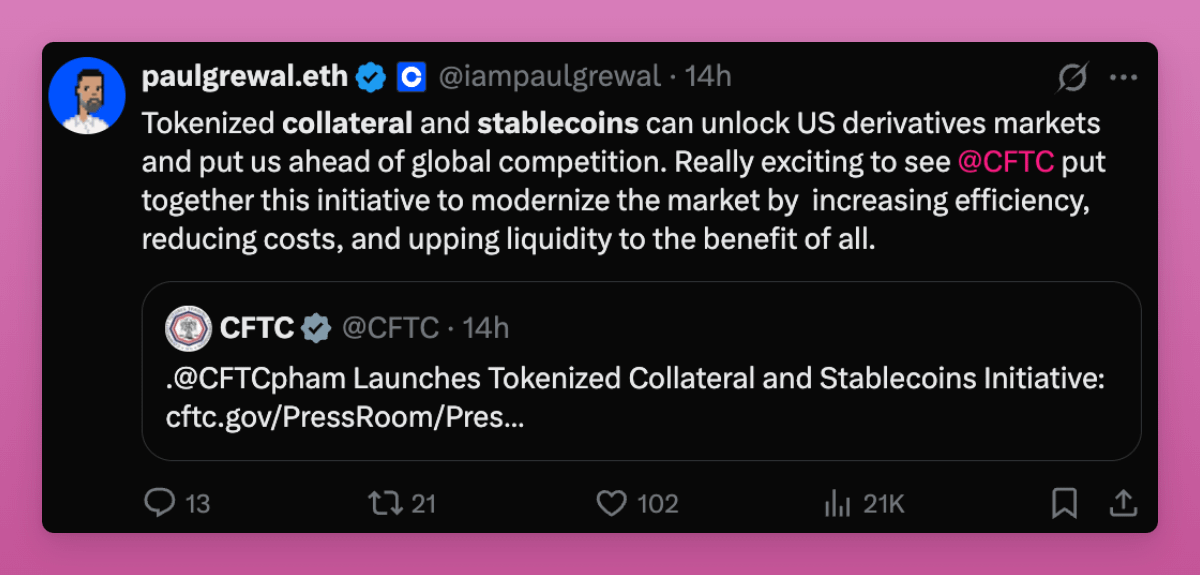
Overall, stablecoins and new stable L1s give credibility to the crypto industry.
Once just a gambling venue, it now holds geopolitical significance. Speculation remains the primary use, but stablecoins are clearly the second-largest application in the crypto space.
The winners are those blockchains and applications that can capture stablecoin flows and convert them into sticky users and cash flow. The biggest unknown is whether new L1s like Tempo and Plasma can become leaders in locking value within their ecosystems, or if Ethereum, Solana, L2, and Tron can push back.
The next big transaction will take place on the Plasma mainnet on September 25.
DAT: New Leverage and IPO Models for Non-ETF Tokens
Digital Asset Treasuries (DATs) concern me.
Every bull market cycle, we find new ways to leverage tokens. This drives prices up far beyond the capacity for spot purchases, but when the market reverses, deleveraging is always brutal. During the FTX collapse, forced liquidations of CeFi leverage crushed the market.
The leverage risk in this cycle may come from DATs. If they issue shares at a premium, raise debt, and invest funds into tokens, they will amplify the upside. However, when market sentiment shifts, these structures could exacerbate the downturn.
Forced redemptions or share buyback fund exhaustion could trigger heavy selling pressure. Therefore, while DATs expand market access and bring in institutional capital, they also introduce a new layer of systemic risk.
We provided an example of what happens when mNAV > 1. In short, they will distribute ETH to shareholders, who are likely to sell. However, despite the "airdrop," BTCS is still trading at 0.74 mNAV. This is bad.
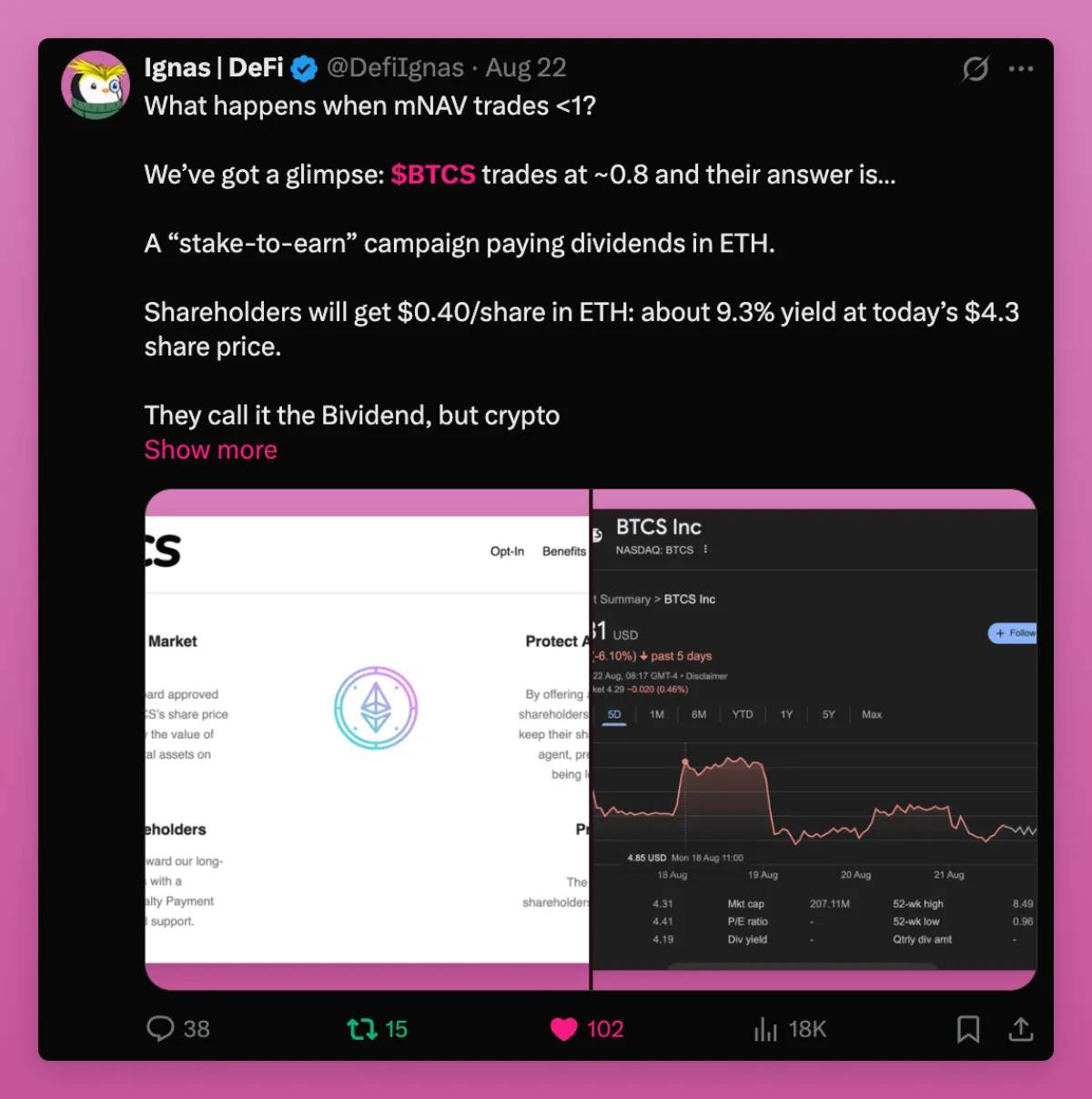
On the other hand, DATs are a new bridge connecting token economies with the stock market.
As the founder of Ethena wrote:
"What worries me is that we may have exhausted crypto-native capital, unable to push altcoins above the peaks of the last cycle. If we look at the total nominal market cap peaks of altcoins in Q4 2021 and Q4 2024, they both hover around $1.2 trillion. Considering inflation-adjusted values, the numbers for both cycles are almost identical. Perhaps this is the limit of global retail capital's ability to bid for 99% of 'air coins'?"
This is why DATs are important.
Retail capital may have peaked, but tokens with real businesses, real revenue, and real users can enter the larger stock market. Compared to the global stock market, the entire altcoin market is just a trivial number. DATs open a door for new capital inflows.
Moreover, since few altcoins possess the expertise required to launch DATs, projects that can do so will redirect attention from millions of tokens to a few "Schelling Point" assets.
He also mentioned that NAV premium arbitrage is not significant; this in itself is a positive.
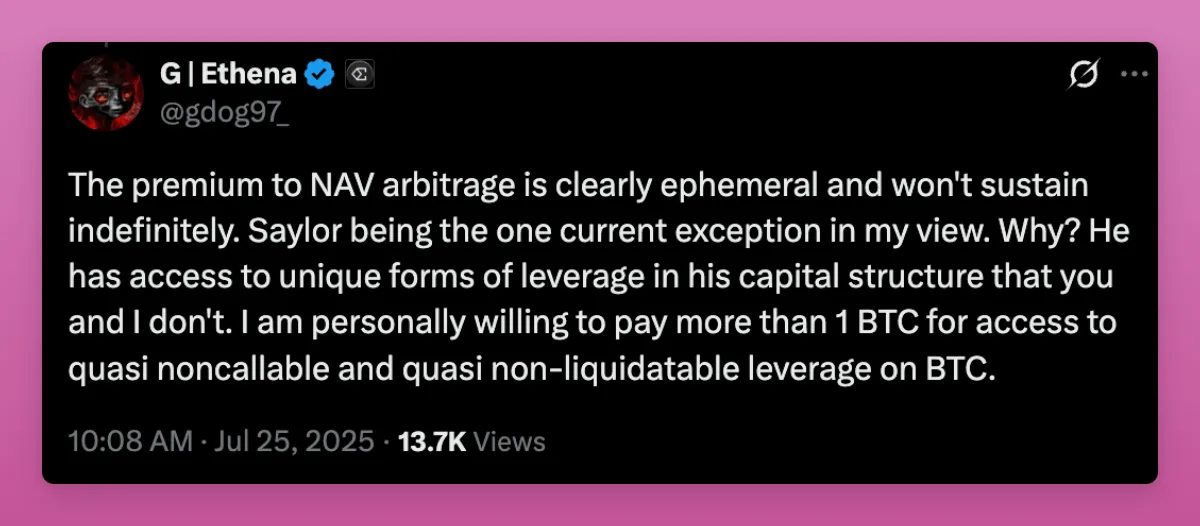
Most DATs cannot leverage capital structures like Saylor to maintain NAV premiums continuously. The true value of DATs lies not in the premium game but in the channels for acquiring capital. Even a stable 1:1 NAV plus ongoing capital inflows is better than being completely unable to access capital.
ENA and even SOL's DATs have faced criticism for being seen as "tools" to cash out tokens held by venture capital funds.
Especially ENA, which is particularly vulnerable due to venture capital funds holding large amounts of tokens. However, due to capital allocation issues, private venture capital funds far exceed the liquidity secondary market demand, and exiting DATs is a positive because venture capital funds can reallocate capital to other crypto assets.
This is important because venture capital funds have been severely impacted in this cycle due to their inability to exit investments. If they can sell and gain new liquidity, they can fund new innovations in the crypto space, thus driving the industry forward.
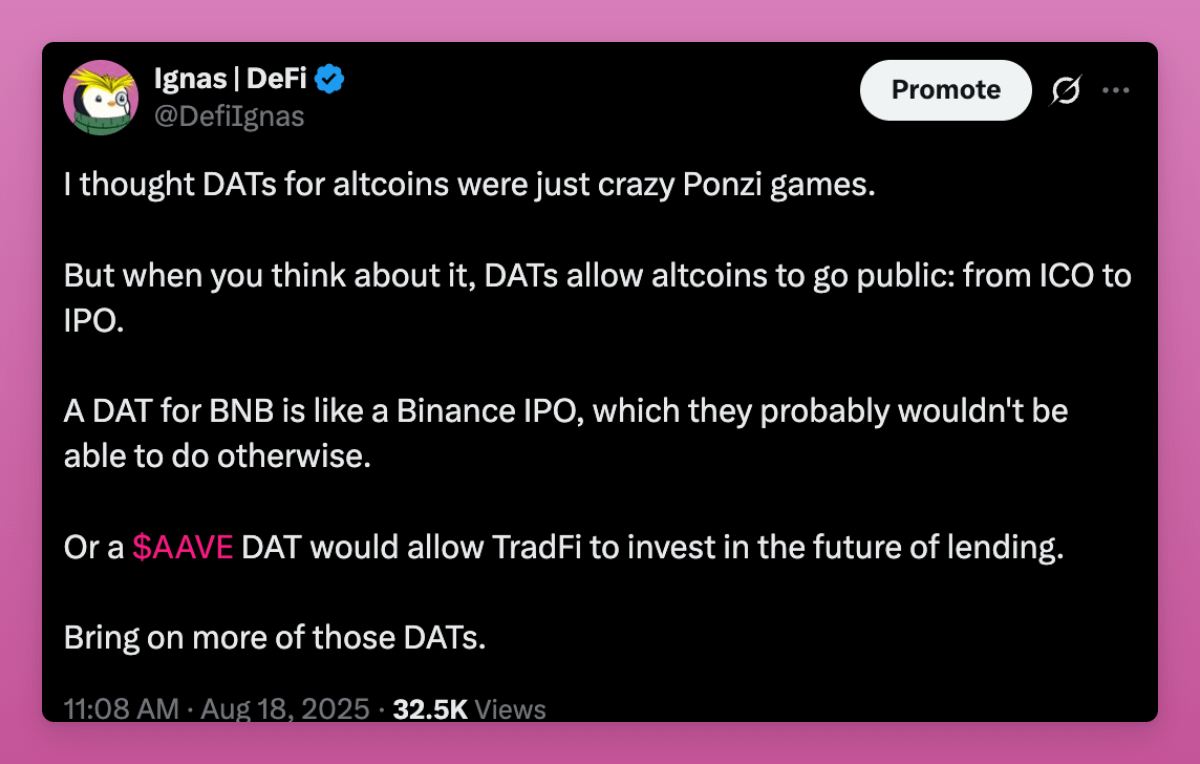
Overall, DATs are bullish on cryptocurrencies, especially those tokens that cannot access ETF support. They allow projects with real users and revenue, like Aave, Fluid, and Hype, to shift investments to the stock market.
Of course, many DATs will fail and have spillover effects on the market. But they also provide ICO projects with the opportunity for IPOs.
RWA Revolution: The Possibility of On-Chain Financial Life
The total market cap of on-chain RWAs has just surpassed $30 billion, growing nearly 9% in just one month. The trend chart continues to rise.
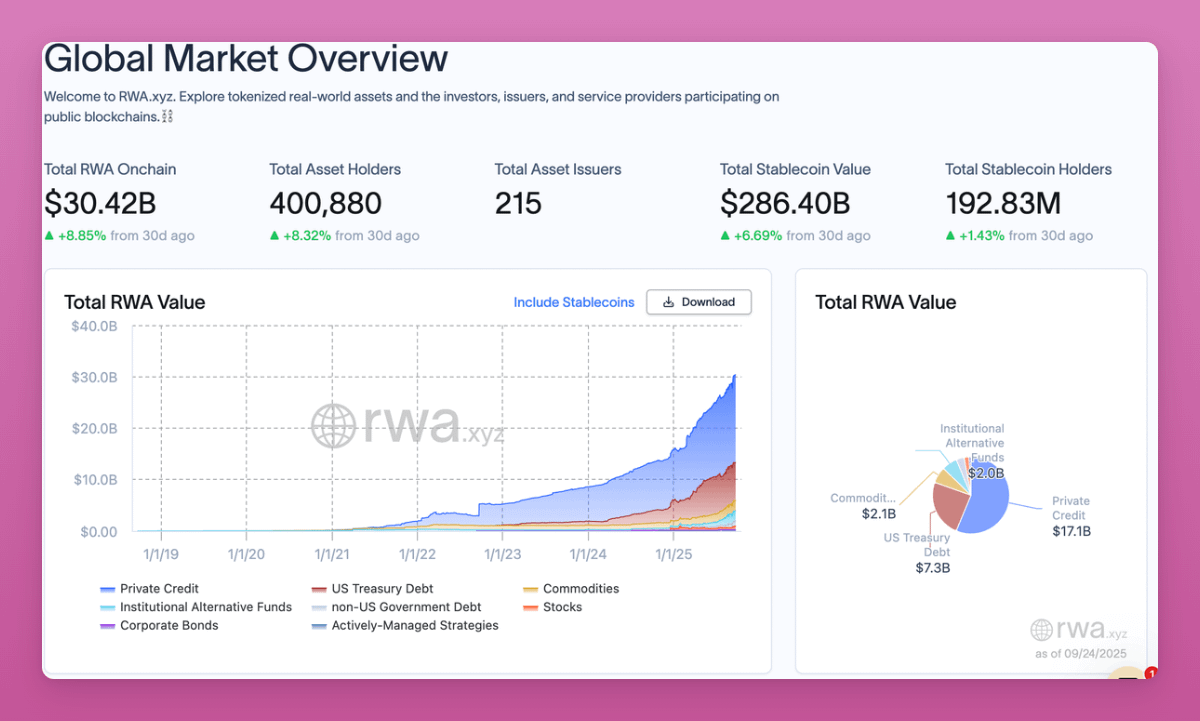
Government bonds, credit, commodities, and private equity have now all been tokenized. The pace of transformation is rapidly increasing.
RWAs are bringing the global economy on-chain. Some significant changes include:
Previously, you had to sell cryptocurrencies for fiat to purchase stocks or bonds. Now, you can continue to hold BTC or stablecoins on-chain, transfer into government bonds or stocks, and self-custody.
DeFi has shed the growth engine of many protocols—the quagmire of "Ponzi schemes." It has brought new revenue sources to DeFi and L1/L2 infrastructure.
The most important change is collateral.
Aave's Horizon allows you to deposit tokenized assets like the S&P 500 index and use them as collateral for borrowing. However, its total locked value (TVL) remains small at just $114 million, indicating that RWAs are still in a relatively early stage. (Note: Centrifuge is working to bring the official SPX500 RWA on-chain. If successful, CFG may perform well. I am optimistic about this.)

Traditional finance has made it nearly impossible for retail to achieve this.
RWAs ultimately make DeFi a true capital market. They set benchmark interest rates through government bonds and credit. They expand global coverage, allowing anyone to hold U.S. Treasury bonds without needing a U.S. bank (which is becoming a global battleground).
BlackRock launched BUIDL, and Franklin launched BENJI. These are not fringe projects but bridges connecting trillions of dollars with cryptocurrencies.
Overall, RWAs represent the most significant structural revolution currently. They make DeFi closely related to the real economy and build the infrastructure for a world that can operate entirely on-chain.
Four-Year Cycle
For the crypto-native market, the most important question is whether the four-year cycle has ended. I hear people around me are already selling, expecting it to reappear. But I believe that as the order of cryptocurrencies changes, the four-year cycle will repeat.
This time is different.
I am betting my assets because:
ETFs are transforming BTC and ETH into institutionally allocable assets.
Stablecoins have become geopolitical tools, now entering payments and capital markets.
DATs open pathways for tokens that cannot access ETF support to enter the stock market while allowing venture capital funds to exit and fund new projects.
RWAs bring the global economy on-chain, creating benchmark interest rates for DeFi.
This is not the casino of 2017, nor the frenzy of 2021.
This is a new era of structure and adoption, where cryptocurrencies are merging with traditional finance while still driven by culture, speculation, and belief.
The next round of winners will not come from a "buy everything" strategy.
Many tokens may still repeat the crashes of the four-year cycle. You need to choose wisely.
The true winners will be those tokens that can adapt to macro and institutional changes while maintaining cultural appeal to retail investors.
This is the new order.
免责声明:本文章仅代表作者个人观点,不代表本平台的立场和观点。本文章仅供信息分享,不构成对任何人的任何投资建议。用户与作者之间的任何争议,与本平台无关。如网页中刊载的文章或图片涉及侵权,请提供相关的权利证明和身份证明发送邮件到support@aicoin.com,本平台相关工作人员将会进行核查。




